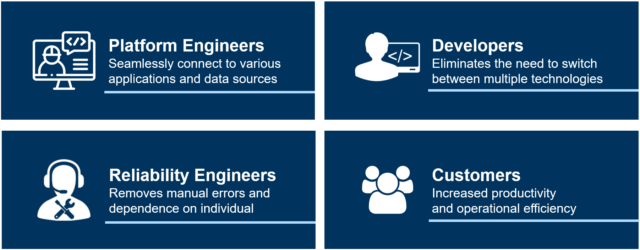Integration-as-a-Service (INaaS) is a Dell Technologies integration service that enables Dell Digital and business teams to build, migrate, monitor and manage a wide range of integration solutions through a unified, easy-to-use, secure and compliant online portal.
Data Integration Platforms (DIP) is an internal organisation within Dell Digital which accelerates business outcomes by providing secure, robust & ‘as-a-service’ platform solutions. These DIP solutions enable the enterprise applications to integrate anything, anywhere and anytime. INaaS plays a key role in facilitating these integration services.
INaaS Scope and Vision
INaaS is one of several frameworks which together are transforming Dell’s Data ecosystem. INaaS key goals are to:
- Provide a cloud-like platform experience for all user personas
- Enable self-service capabilities, addressing time-to-availability
- Assess total cost of ownership for each integration
- Optimise infrastructure spending
The INaaS portal is a one-stop shop for users to manage the Integration requests/services. The focus is to create a cloud-like experience on the current integration infrastructure and leverage the DevOps processes in the back end to perform the actual operations on the integration platform. This portal serves as a control interface for administrative actions and workflow capabilities. It provides various metrics to deduce usage of the INaaS services. It is compliant to Dell Design System standards, built on extendable architecture/framework and supports co-development models to launch new utilities and accelerate outcomes.
Self-Service Utilities
‘Build’, ‘Migrate’ and other utilities allow developers to perform Day-1 and Day-2 pre-packaged operations. Developers can set up an integration solution, across any data integration platform, in a secure and governed way without direct involvement from anyone else. These utilities minimise IT engagements, deliver high quality solutions, and accelerate outcomes by removing barriers to resources. The utilities are simple, yet powerful and scalable to be easily adopted by anyone.
Self-Discovery and Smart Monitoring
Self-Discovery is a home-grown framework across all the Integration platforms to automatically identify the integration solutions hosted on each platform. This framework enables users to catalog the existing integration solutions and track transactions by each integration. ‘Smart Monitoring’ enables a standardised approach across all platforms to track overall health. This service also generates alerts based on the weightage of a degraded component. Several reports have been developed as part of this effort to offer a single consolidated view and provide data-driven and insightful/value-based conversations with our customers. The data also provide insights to optimise our platform resources based on the actual consumption.
Total Cost of Ownership, Capacity Buy Back
Metering and showback involve capturing chargeable usage at the right level of granularity in the integration platform. The metering system then calculates the total cost of ownership for each integration. Examples of this could be measuring file sizes in GB for MFT platforms, EDI message counts for B2B, time taken by queries in seconds for Streaming, CPU time for Messaging etc. ‘Transaction Cost Metrics’ calculates the cost of each transaction using a simple averaging technique of total OpEx and CapEx by platform over the total volume each platform supports.
‘Capacity Management’ is an extension of transaction monitoring and metering. Like any cloud vendors, to ensure lower cost solutions, it is important to shed excess capacity and keep the platforms lean. At the same time, it needs a fine balance to have enough capacity to support burst volume and organic expansion. ‘Infrastructure Utilisation’ and ‘Zero Transaction Metrics’ allow the platform team to identify inactive or obsolete integration solutions. These solutions optimise the platform size dynamically.

Delivering Business Value, User Experience
Different user personas need and expect different experiences. Over the last three years, INaaS has matured significantly and has been adopted across the enterprise. The portal currently handles about 700+ platform engagement requests and around 2,000 self-service requests a month, across nine different integration platforms. Business value gained is driven by the efficiencies gained by Developers, Platform Engineers, Reliability Engineers and Customers. There are added benefits related to improved security and compliance from a Dell-controlled secure ecosystem. Another benefit is a cost model to incentivise efficient utilisation and reward efficient resource utilisation by giving back resources due to faster and improved quality of integration solution delivery.

The framework is also being extended to include forecasting techniques, which will capture demand profile data. It will make decisions on future needs of integration solutions to perform business functions and adopting the hybrid cloud strategy. This new forecasting technique will transform the on-premise integration platforms experience like on cloud.
Looking ahead, we are focused on expanding the utilities for 100 percent end-to-end activities across three platforms by end of this year and across all integrations platforms next year.


